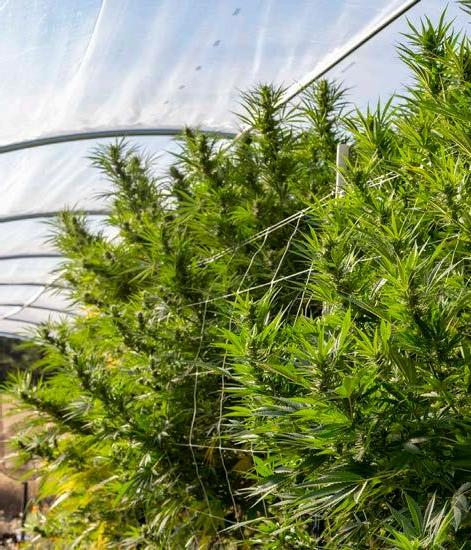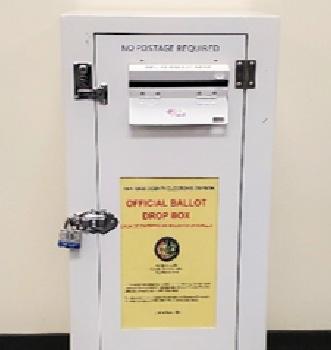
4 minute read
COVER
VC 2020 ELECTION Ventura County’s
Measure O
Will voters allow greenhouse cannabis cultivation?
by Kimberly Rivers
kimberly@vcreporter.com
Measure O is on the ballot, finally putting the question of whether or not cannabis can be commercially grown in the county before the voters.
“Although we would have wanted this ballot measure to include outdoor cultivation and retail sales, for conservative unincorporated Ventura County this is a long overdue first step towards allowing commercial cannabis activity,” states Sespe Creek Collective, a dispensary in Ojai, on its website. “We welcome the opportunity to source products grown locally in our region and hope this will provide new options for small farmers.”
The county already allows industrial hemp to be grown and has issued permits for 4,000 acres of hemp growing in the county. But cannabis is the plant that is used for activities that up until recent years were illegal. California has so far left the decision up to counties and cities to decide whether to allow commercial cannabis growing in their jurisdictions.
Last month the Ventura County Board of Supervisors received a report on Measure O and the proposition’s potential impacts in the county, commissioned from HdL Consulting (HdL), an Orange County-based firm with expertise in cannabis policy, regulation and compliance.
What would Measure O allow?
The measure, if passed by a simple majority of voters, would allow up to 500 cumulative acres countywide of cannabis to be grown for commercial purposes in already existing greenhouses or other indoor facilities, in the unincorporated areas of Ventura County. The plant could only be grown in areas zoned exclusively for agricultural purposes and industrial activities (AE, M1 and M2 zones).
An additional 100 acres of nurseries could be permitted to house plants for sale and some ancillary and processing activities would be allowed as needed with cultivation activities. All growers would have to comply with state laws, and receive a county-issued license.
The measure approves a 4 percent tax on gross receipts from proceeds related to cultivation and a 1 percent tax on gross receipts related to nurseries. Those levels match taxes already in effect in Santa Barbara County. Proceeds would be part of the county’s general fund and could be used for any expense.
Applications for commercial cultivation could be submitted starting Jan. 1, 2021, approved on a first-come, first-served basis. Permission to grow would be ministerial, meaning the county must grant permission if the applicant meets all conditions and the permit would not result in acreage maximums
CITY CANNABIS MEASURES:
Ojai’s Measure G: Would place a 3 percent tax on cannabis sales in the city of Ojai, with potential for generating $465,000 to $1.5 million annually for the city’s general fund. Authorizes up to 10 percent tax. Local dispensaries generally oppose the measure, saying the cost will get passed on to consumers already paying high state and federal taxes on cannabis products.
Ventura’s Measure I: Annual tax on both cannabis and hemp cultivation that would not exceed $10 on each “canopy” square foot, 8 percent of gross receipts (retail) and 4 percent for other cannabis businesses if the city legalizes retail sales in the future. being exceeded. Licenses would be renewed each year.
Measure O would require perimeter security systems that include 24-hour video monitoring and lighting, exceeding state standards. In addition, the law would require the use of “best available control technology” for controlling odors from the greenhouses, but that may not eliminate all odor, which has been a major issue for residents who currently live near areas where industrial hemp is being grown.
What does Measure O not allow?
Measure O would not allow manufacturing activities associated with cannabis, nor would it allow retail sales — something the county does not currently allow. Some cities in the county do allow retail sales.
The application of conventional pesticides and herbicides to cannabis is generally prohibited in California.
The measure sets a 1,200-foot buffer zone around certain sensitive uses including schools, youth centers and residential neighborhoods.
Measure O does not create any additional tax on processing or distribution of cannabis products.
If Measure O passes…
Based on HdL’s assessment, there are only 220 acres of existing greenhouse in the county that meet the requirements of Measure O. The report highlighted that there are currently only 347.5 acres of greenhouse cultivation of cannabis in the entire state, with 62 acres in Santa Barbara County. The law would not lead to new greenhouse construction, but could result in about 72 new jobs (annual payroll of about $3 million) and four new farmworker housing areas.
Based on the report’s assessment, it is expected that four growers would be active in the county, each with about 60,000 square feet of growing area, or under two acres of greenhouse space used for growing cannabis. But the initiative would not limit the number of growers, just the total acreage, cumulatively, of all growers.
The measure is unlikely, however, to deter illegal cultivation in the nearby national forests, reports HdL, because it does not allow licensed retail sales in the unincorporated county, continuing an incentive for black market, unlicensed sellers. All licensed growers have to sell to licensed retailers. So the measure doesn’t create a solution to the black market sale of cannabis products.
HdL notes that licensing growers and sellers can reduce the scope of the illegal black market in cannabis, but also pointed out that their opinion differs from that of the Ventura County Sheriff’s Office, which in some cases thinks that legal, licensed growers can be “linked to criminal black market operations,” and may be a target of crime including armed robbery.
It is estimated that $2.92 million from cultivation and nurseries would be generated annually in tax revenue.
HdL’s report and other documents are online at: bosagenda.countyofventura.org/sirepub/agdocs.aspx?doctype=agenda&itemid=110375



